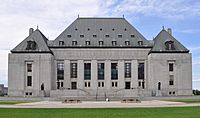Calder v British Columbia (AG) facts for kids
Quick facts for kids Calder v British Columbia (AG) |
|
|---|---|

|
|
| Hearing: November 29 - December 3, 1971 Judgment: January 31, 1973 |
|
| Full case name | Frank Calder et al., suing on their own behalf and on behalf of All Other Members of the Nishga Tribal Council, and James Gosnell et al., suing on their own behalf and on behalf of the Gitlakdamix Indian Band, and Maurice Nyce et al., suing on their own behalf and on behalf of All Other Members of the Canyon City Indian Band, and W.D. McKay et al., suing on their own behalf and on behalf of All Other Members of the Greenville Indian Band, and Anthony Robinson et al., suing on their own behalf and on behalf of All Other Members of the Kincolith Indian Band v. Attorney-General of British Columbia |
| Citations | [1973] SCR 313 |
| Prior history | Judgment for the Attorney General of British Columbia in the British Columbia Court of Appeal. |
| Ruling | Appeal dismissed. |
| Holding | |
| While aboriginal title can exist, more was required to demonstrate that the aboriginal bands in question had such title. | |
| Court membership | |
| Chief Justice: Gérald Fauteux Puisne Justices: Douglas Abbott, Ronald Martland, Wilfred Judson, Roland Ritchie, Emmett Hall, Wishart Spence, Louis-Philippe Pigeon, Bora Laskin |
|
| Reasons given | |
| Majority | Judson J, joined by Martland and Ritchie JJ |
| Concurrence | Pigeon J |
| Dissent | Hall J, joined by Spence and Laskin JJ |
| Fauteux CJ and Abbott J took no part in the consideration or decision of the case. | |
Calder v British Columbia (AG) was a very important court case in Canada. It happened in 1973 at the Supreme Court of Canada. This case was the first time Canadian law officially recognized that Indigenous peoples had rights to their land even before European settlers arrived. This right wasn't given by new laws; it was something they already had.
Understanding the Calder Case
This court case was a big step for Indigenous rights in Canada. It changed how the government and courts thought about land that Indigenous peoples had lived on for centuries.
The Nisga'a Nation's Claim
In 1969, Frank Arthur Calder and the Nisga'a Nation Tribal Council started a lawsuit. They asked the British Columbia government to confirm that their traditional land rights, called "aboriginal title," had never been legally taken away.
Early Court Decisions
When the case first went to court and then to an appeals court, the judges decided against the Nisga'a. They believed that if aboriginal title had ever existed, it was no longer valid.
The Supreme Court's View
The Nisga'a Nation then took their case to the highest court in Canada, the Supreme Court. The Supreme Court judges agreed that the Nisga'a had "aboriginal title" to their lands when European settlers first arrived.
Why the Court Agreed
- Justice Judson, writing for some of the judges, said the Nisga'a were "organized in societies." They had "occupied the land as their forefathers had done for centuries."
- Justice Hall, writing for other judges, said the Nisga'a had "possession from time immemorial." This means they had lived on and used the land since before anyone could remember.
- Justice Hall also found support for aboriginal title in the Royal Proclamation of 1763. This was a British law that recognized Indigenous land rights.
The Court's Split Decision
Even though the Supreme Court agreed that aboriginal title existed, the judges were split. Three judges thought the Nisga'a's title was still valid. The other three thought it had been "extinguished," meaning it was no longer in effect.
Two Ways to End Aboriginal Title
The judges had different ideas about how aboriginal title could be ended:
- Justice Judson's View: He asked if the government had taken "complete control" over the land. He believed that if the government acted like they fully owned the land, it could end aboriginal title. He felt that the British Columbia government had done this through various actions.
- Justice Hall's View: He believed that only a clear and specific law passed by the government could end aboriginal title. This law would have to show a "clear and plain" intention to do so. Since no such law existed for the Nisga'a, he concluded their title was still valid.
Which View Won?
Because the judges were split 3-3, the appeal was dismissed. This meant the Nisga'a did not win their case at that time. However, Justice Hall's "clear and plain" test for ending aboriginal title was later accepted as the correct way in another important case called R v Sparrow in 1990.
Justice Pigeon's Role
Justice Pigeon agreed with the final decision to dismiss the appeal. However, he did not decide on the main issues of the case. He dismissed the appeal for technical reasons related to how the case was brought to court.
What Happened After the Case?
The Calder decision had a huge impact on Canada.
Changes to Land Claims
Because of this case, the Canadian government completely changed how it dealt with land claims from Indigenous peoples. It opened the door for new negotiations.
Future Court Cases
The idea of aboriginal title was further developed in later Supreme Court cases. These include:
- Guerin v The Queen (1984)
- Delgamuukw v British Columbia (1997)
- Tsilhqot'in Nation v British Columbia (2014)
The Lawyer for the Nisga'a
The lawyer who argued the case for the Nisga'a was Thomas Berger. This was one of his first major cases working on Canadian Aboriginal law. He later became a judge.
See also

